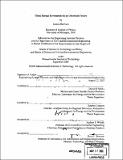| dc.contributor.advisor | David H. Marks and Stephen Connors. | en_US |
| dc.contributor.author | Harrison, Jessica (Jessica Kit) | en_US |
| dc.contributor.other | Massachusetts Institute of Technology. Dept. of Civil and Environmental Engineering. | en_US |
| dc.date.accessioned | 2006-11-07T12:43:42Z | |
| dc.date.available | 2006-11-07T12:43:42Z | |
| dc.date.copyright | 2005 | en_US |
| dc.date.issued | 2005 | en_US |
| dc.identifier.uri | http://hdl.handle.net/1721.1/34520 | |
| dc.description | Thesis (S.M.)--Massachusetts Institute of Technology, Engineering Systems Division, Technology and Policy Program; and, (S.M.)--Massachusetts Institute of Technology, Dept. of Civil and Environmental Engineering, 2005. | en_US |
| dc.description | Includes bibliographical references. | en_US |
| dc.description.abstract | The energy sector faces a multitude of challenges related to climate change and energy security. These challenges will likely prompt considerable changes in the coming decades, including significant investment and new market design. To help fulfill multiple goals and limit the necessary tradeoffs among them, industry and policymakers alike are looking to new technologies. However, uncertainty regarding the challenges, the solutions, and the behavior of the energy system, make it difficult to discern which investment is right for what time. This thesis reviews the potential changes in today's energy system and examines the difficulties of addressing challenges that appear urgent yet elusive. An extensive literature review considers the problems of clean energy investment decision-making in modern energy systems, and evaluates the potential contributions of a real options approach and system dynamics. A case study on the market growth of Gas-to-Liquids technology provides more detail on the use of system dynamics to gauge market uncertainties. Admitting to the lack of appropriate tools to objectively evaluate strategies for tackling today's energy challenges, this thesis helps answer why such questions as the appropriate timing investment are so difficult to answer, and contentious. | en_US |
| dc.description.abstract | (cont.) Ultimately, it suggests a framework for considering the problem of clean energy investments under uncertainty. It considers a real options approach and system dynamics, despite their limitations, as a start for developing sophisticated tools to help grapple with investment uncertainties and to create thoughtful, strategic plans. | en_US |
| dc.description.statementofresponsibility | by Jessica Harrison. | en_US |
| dc.format.extent | 96 p. | en_US |
| dc.format.extent | 7160104 bytes | |
| dc.format.extent | 7164069 bytes | |
| dc.format.mimetype | application/pdf | |
| dc.format.mimetype | application/pdf | |
| dc.language.iso | eng | en_US |
| dc.publisher | Massachusetts Institute of Technology | en_US |
| dc.rights | M.I.T. theses are protected by copyright. They may be viewed from this source for any purpose, but reproduction or distribution in any format is prohibited without written permission. See provided URL for inquiries about permission. | en_US |
| dc.rights.uri | http://dspace.mit.edu/handle/1721.1/7582 | |
| dc.subject | Technology and Policy Program. | en_US |
| dc.subject | Civil and Environmental Engineering. | en_US |
| dc.title | Clean energy investments in an uncertain future | en_US |
| dc.type | Thesis | en_US |
| dc.description.degree | S.M. | en_US |
| dc.contributor.department | Massachusetts Institute of Technology. Department of Civil and Environmental Engineering | |
| dc.contributor.department | Massachusetts Institute of Technology. Engineering Systems Division | |
| dc.contributor.department | Technology and Policy Program | |
| dc.identifier.oclc | 70900899 | en_US |
